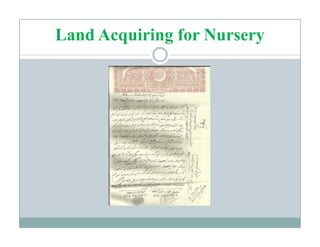Presentation About Ficus trees Plantation Project
- 1. Project Title Plantation of 1000 Ficus Trees (Banyan and Pipal) for restoration of habitat of more than 100 avian species in District Kasur, Punjab, Pakistan
- 2. Project Information  Project Cost  WWF-P Funding  Partner’s Share  Project Duration  Project Start Date  Project End Date : Rs. 415,000 : Rs. 300,000 : Rs. 115,000 : One Year : April 12, 2012 : April 11, 2013
- 3. PROJECT LOCATION & BENEFICIARIES Local Communities of 12 villages in District Kasur
- 4. PROJECT OBJECTIVES ď‚— Habitat restoration of more than 100 avian, mammalian and reptilian species ď‚— Afforestation through planting 1000 Ficus trees ď‚— Environmental education and awareness raising among the local communities ď‚— Support to the local culture associated with the Ficus trees in the study area
- 5. Methodology Nursery Raising for Ficus trees included Vegetative Propagation Method. Among Vegetative Propagation Method following two techniques were adopted; A. Plant Cutting B. Air layering Note: In addition, 100 % success was observed while experiencing seed germination
- 6. Results ď‚— 1,200 Banyan plants have been planted at 100 different sites in a ď‚— ď‚— ď‚— ď‚— ď‚— stretch of 20 x 10 km in the project area 2,300 Pipal plants have been planted in the project area Awareness raising campaign Motivation / sensitizing to the local communities Identifying local partner CBOs The foundation stone of habitat restoration have been laid in the project area and it is expected that in the coming few years, the planted 3,500 Ficus trees will add to the habitat of different faunal species
- 7. Project’s outputs not achieved and reasons? All the project outputs have not only been achieved but some extra activities have also been conducted. These include development of techniques for;  Pipal seed extraction  Pipal seed germination  Air layering preparation  Plantation of trees in far beyond number than the agreed number in the project i.e. 3500 trees in place of 1000
- 8. Conclusions & Recommendations ď‚— There is a misconception that Pipal trees are not the preferred tree species. The Safwan Foundation has received a number of applications demanding the Pipal trees in large numbers due to its being non-shady characteristics and having a timber value. ď‚— Air layering is a time saving technique but if we want to plant millions of trees than bottle method is best and cheapest among all. ď‚— The time span (one Year) is too short for Ficus trees project. A minimum 3-year project should be launched to get the excellent results. ď‚— Due to high fluctuations in fuel prices, transportation is very expensive and nursery raising is a capital intensive as well as labor intensive followed by knowledge/skill intensive job, due to above mentioned factors minimum 0.6 million (PKR) is a recommended amount for such a project.
- 9. VISITING OF PLANT NURSERIES
- 10. The Staff of SF visited 25 Nurseries ď‚— The staff of Safwan Foundation visited 25 nurseries in Pattoki to obtain the Pipal Seedlings, 24 of them totally refused to provide even a single plant. Only the Zam Zam nursery claimed that they had the seedlings. They demanded 200 PKR per one year old plant. Later we visited the site and witnessed the plant seedlings. ď‚— Mr. Muhammad Saleem 0300-4092929. ď‚— Mr. Muhammad Ghaffar 0300-4086363. ď‚— Zam Zam Nursery.
- 11. Selection of Sites with GPS CO-Ordinates
- 12. Community Participation- The Volunteers
- 13. Involvement of local Communities
- 14. TWO PUPPET SHOWS
- 15. Agreements with local °äµţ°żâ€™s
- 16. Land Acquiring for Nursery
- 17. Preparation & Conservation of Rooting Hormones
- 18. Types of Rooting Hormones ď‚— K-IBA 0.5/500 ml with Acetone water soluble. ď‚— Indole Butyric Acid (C12 H13 NO2=203.74) 1gm/1000 gm.powder based IBA. ď‚— Willow Tea . ď‚— Aspirin as rooting hormones.
- 19. Propagation via Vegetative Means ď‚— Plant Cutting ď‚— Air Layering ď‚— Head Cutting
- 20. Propagation via Seed ď‚— Pot Method ď‚— Bottle Method ď‚— This method is very easy ď‚— The bottle method is also and cheap. cheap, although this is a bit tricky method but germination rate is amazingly high.
- 21. Inspection of the Project
- 22. Preparation for Pipal Seedlings
- 24. Promotional Material-Undertaking by volunteers
- 25. Slogans in the form of brouchers/handouts
- 26. Messages
- 27. Media Coverage
- 28. Total Plantation ď‚— Banyan (Ficus benghalensis) ď‚— ď‚— ď‚— ď‚— 1200 plants Pipal (Ficus religiosa ) 2300 plants Grand total 3500 plants Back up Stock 5000 Plants Achieved 3 times than the original target.
- 29. Recommendations ď‚— The time span (one Year) is too short for ficus trees. minimum 3 years required to chase the excellent results. ď‚— Due to high fluctuations in fuel prices transportation is very expensive and nursery raising is a capital intensive as well as labor intensive followed by knowledge/skill intensive job, due to above mentioned factors minimum 0.6 million (PKR) is a recommended amount for such a project.
- 30. Thanks to WWF-P ď‚— I, on the behalf of my supporters and volunteers of Safwan Foundation, Samaj Sewa Development Foundation and Heaven East Community Board are thankful to WWF-P for their financial and technical assistance for the successful completion of this long term habitat restoration project . ď‚— Safwan Shahab Ahmed/Project Executant






























